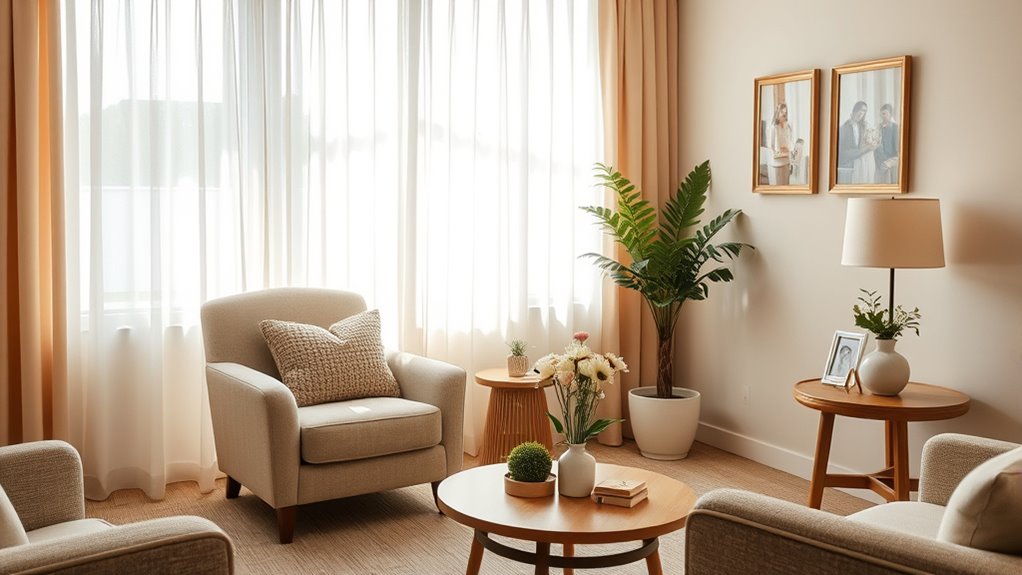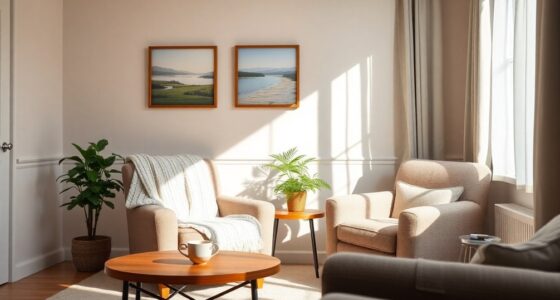To calm anxiety in memory care rooms, focus on creating a familiar, safe environment with gentle lighting, soft colors, and minimal clutter. Incorporate personal touches like photos and favorite items, and add sensory elements like calming sounds and subtle scents. Clear signage and contrasting accents help with navigation, reducing confusion. Simple yet thoughtful design tweaks can turn a stressful space into a peaceful retreat—exploring these secrets further can make all the difference.
Key Takeaways
- Incorporate soft, muted colors and gentle lighting to create a calming, non-overstimulating environment.
- Use familiar objects, personal photos, and cozy textures to foster comfort and reduce disorientation.
- Design wide, uncluttered pathways with clear signage and contrasting colors for easy navigation and safety.
- Include sensory-friendly features like soft music, nature sounds, and subtle aromatherapy to promote relaxation.
- Minimize distractions and overstimulation through simple furnishings and intentional use of calming visual cues.

Memory care rooms are specially designed spaces that provide a safe and supportive environment for individuals with Alzheimer’s disease and other forms of dementia. These rooms aren’t just about safety; they’re created to reduce anxiety, promote calmness, and foster a sense of familiarity. When you walk into a well-designed memory care room, you’ll notice how thoughtfully every detail is chosen to make residents feel comfortable and secure. Bright, natural lighting is often used to boost mood and help with orientation, while muted colors and soft textures avoid overstimulation. The goal is to create a space where residents can feel at ease without feeling overwhelmed or disoriented.
Memory care rooms promote safety, calmness, and familiarity through thoughtful design and sensory-friendly features.
One of the key secrets to calming anxiety through design is simplicity. Cluttered rooms can cause confusion or agitation, so these spaces tend to be minimally furnished with only essential, familiar items. You’ll see wide, clear pathways that make navigation straightforward, reducing the chance of falls or frustration. Familiar objects, like a favorite chair or personal photos, are strategically placed to evoke positive memories and provide comfort. These touches help residents recognize their environment, making it easier for them to settle into a peaceful state. Incorporating sensory-friendly features such as gentle sounds and textures further enhances this calming environment.
Another important aspect is the use of sensory-friendly features. Soft, soothing sounds—like gentle music or nature sounds—are often incorporated to create a calming atmosphere. Aromatherapy, with subtle, familiar scents, can also be used to promote relaxation. Textures matter too; cozy blankets or soft cushions give tactile comfort, helping residents stay grounded. Visual cues are carefully integrated, with clear signage or color-coded areas that assist with orientation without overwhelming the senses. For example, contrasting colors on doorframes or furniture can guide residents subtly, helping them find their way without confusion.
Family members swear by these design secrets because they see the difference it makes in daily well-being. They notice less agitation and more moments of peace when the environment is tailored to their loved ones’ needs. Simple adjustments—like removing confusing clutter, using familiar objects, and creating sensory-rich yet soothing surroundings—can transform a stressful situation into one of calm and reassurance. The design principles focus on understanding the unique needs of each individual, ensuring their environment contributes positively to their mental health and safety. When you choose or help create a memory care room with these features, you’re fostering a space where your loved one can feel safe, valued, and at peace every day.
Frequently Asked Questions
How Do Sensory Elements Reduce Anxiety in Memory Care Rooms?
Sensory elements reduce anxiety in memory care rooms by creating a calming environment that engages the senses gently. Soft lighting, soothing sounds, and calming scents help your loved one feel safe and relaxed. Tactile objects like textured blankets or soft furniture provide comfort, while visual cues minimize confusion. By thoughtfully integrating these sensory elements, you help reduce stress and promote a sense of calm, making the space more welcoming and comforting.
Are There Customizable Features for Individual Resident Needs?
Yes, there are customizable features for individual resident needs. You can tailor sensory elements like personalized lighting, familiar objects, or specific scents to each person’s preferences. Adjustable furniture and technology also allow you to create a space that feels safe and comfortable. By customizing these features, you help reduce anxiety and promote a sense of familiarity, making the environment more supportive and calming for each resident.
What Role Does Color Psychology Play in Room Design?
Color psychology plays a pivotal role in designing memory care rooms by influencing residents’ emotions and reducing anxiety. You can use calming shades like soft blues and greens to promote relaxation, while warm tones like gentle yellows create a welcoming atmosphere. By choosing the right colors, you help residents feel more at ease and secure, making their environment more soothing and supportive of their well-being.
How Can Family Input Improve Room Comfort?
Did you know that family input can increase a resident’s comfort by up to 30%? You can make a big difference by sharing your insights about your loved one’s preferences and routines. Your feedback helps caregivers design spaces that feel familiar and safe, reducing anxiety. By actively participating, you guarantee the environment reflects your loved one’s personality, making their daily experience more calming and personalized.
What Are the Cost Implications of Implementing These Design Secrets?
Implementing these calming design secrets can vary in cost, but you’ll often find that the benefits outweigh expenses. Simple updates like soothing paint colors or soft lighting are affordable, while adding specialized furniture or technology may increase costs. However, investing in a calming environment can reduce agitation and improve quality of life, potentially lowering care costs over time. Focus on prioritizing changes that balance your budget with the desired comfort and effectiveness.
Conclusion
Creating a calming memory care room is like planting a safe harbor where your loved one can find peace amid chaos. By incorporating gentle colors, familiar objects, and soothing lighting, you craft a space that eases anxiety and nurtures comfort. These design secrets become the steady lighthouse guiding your family through challenging waters, showing that a thoughtfully designed room isn’t just about aesthetics—it’s about giving your loved one a sanctuary where they can truly feel safe and at home.









